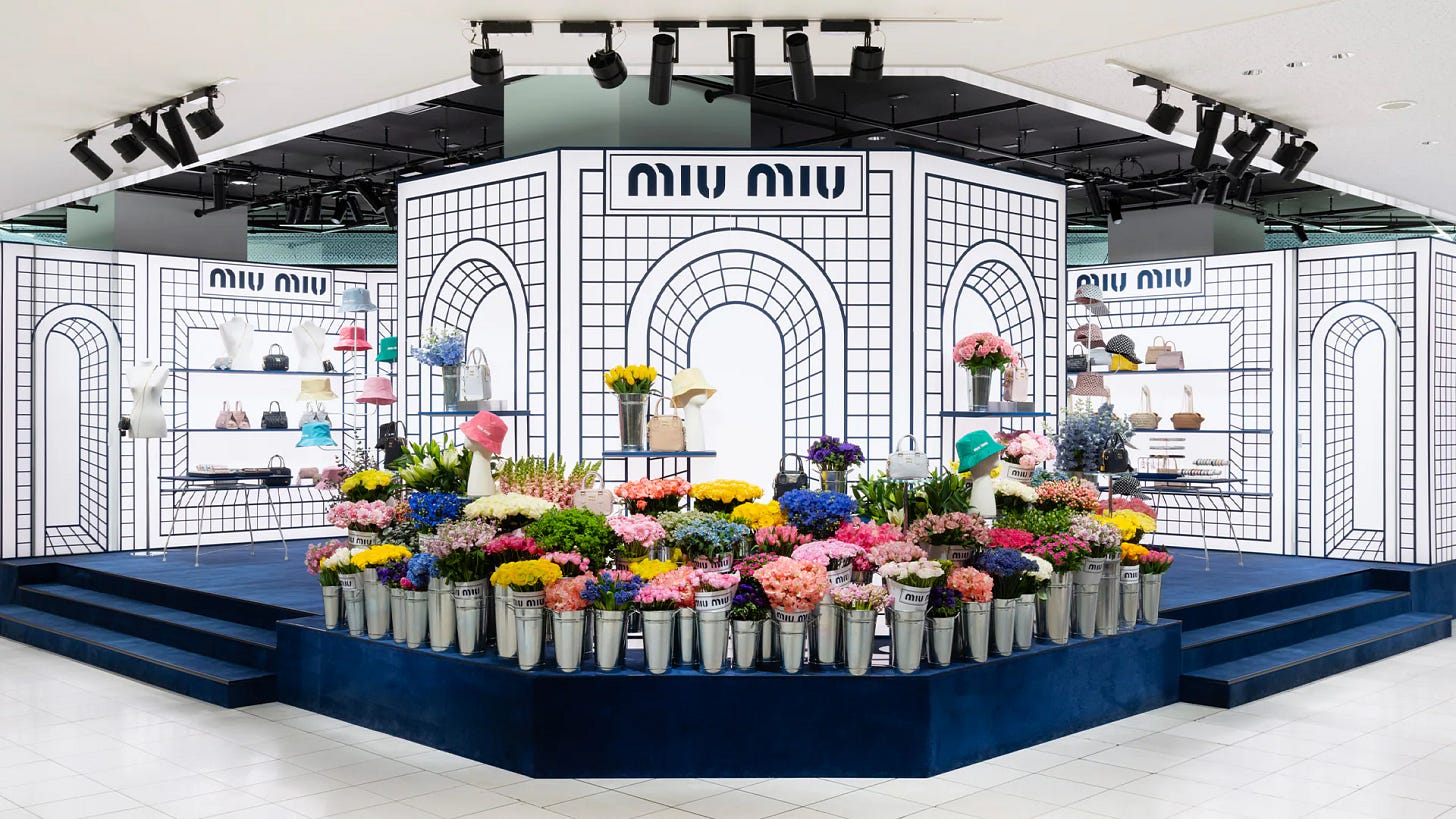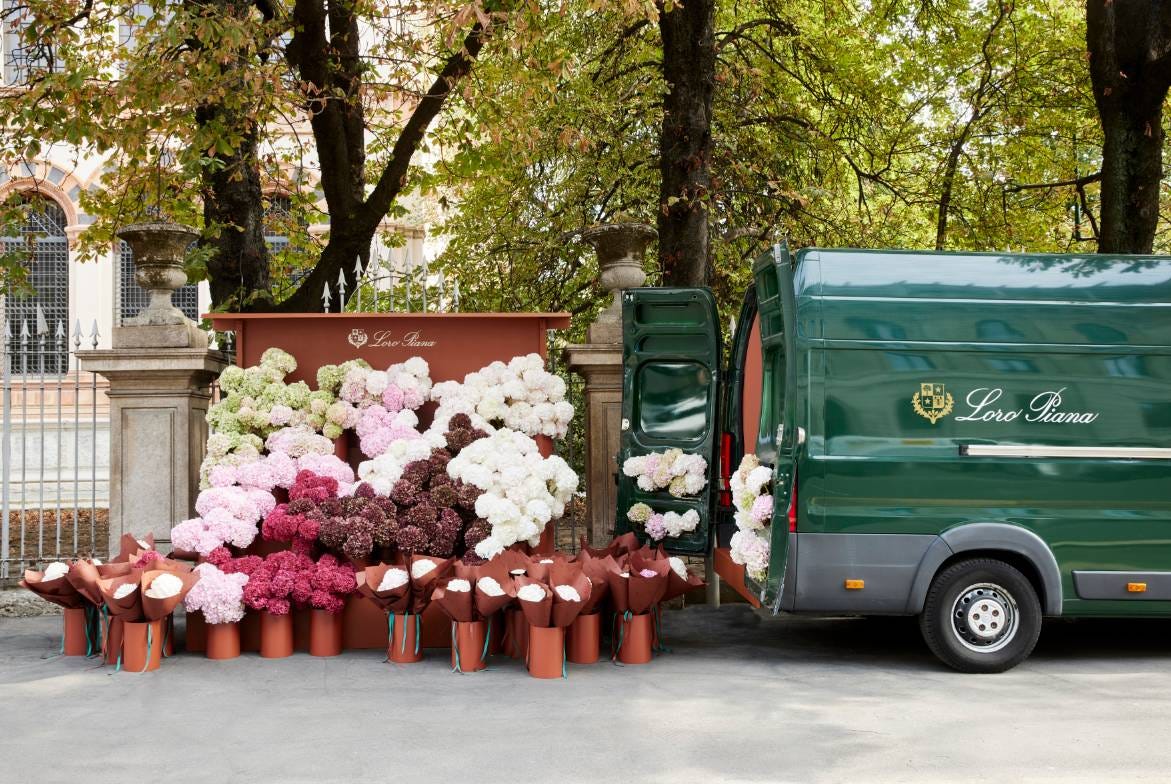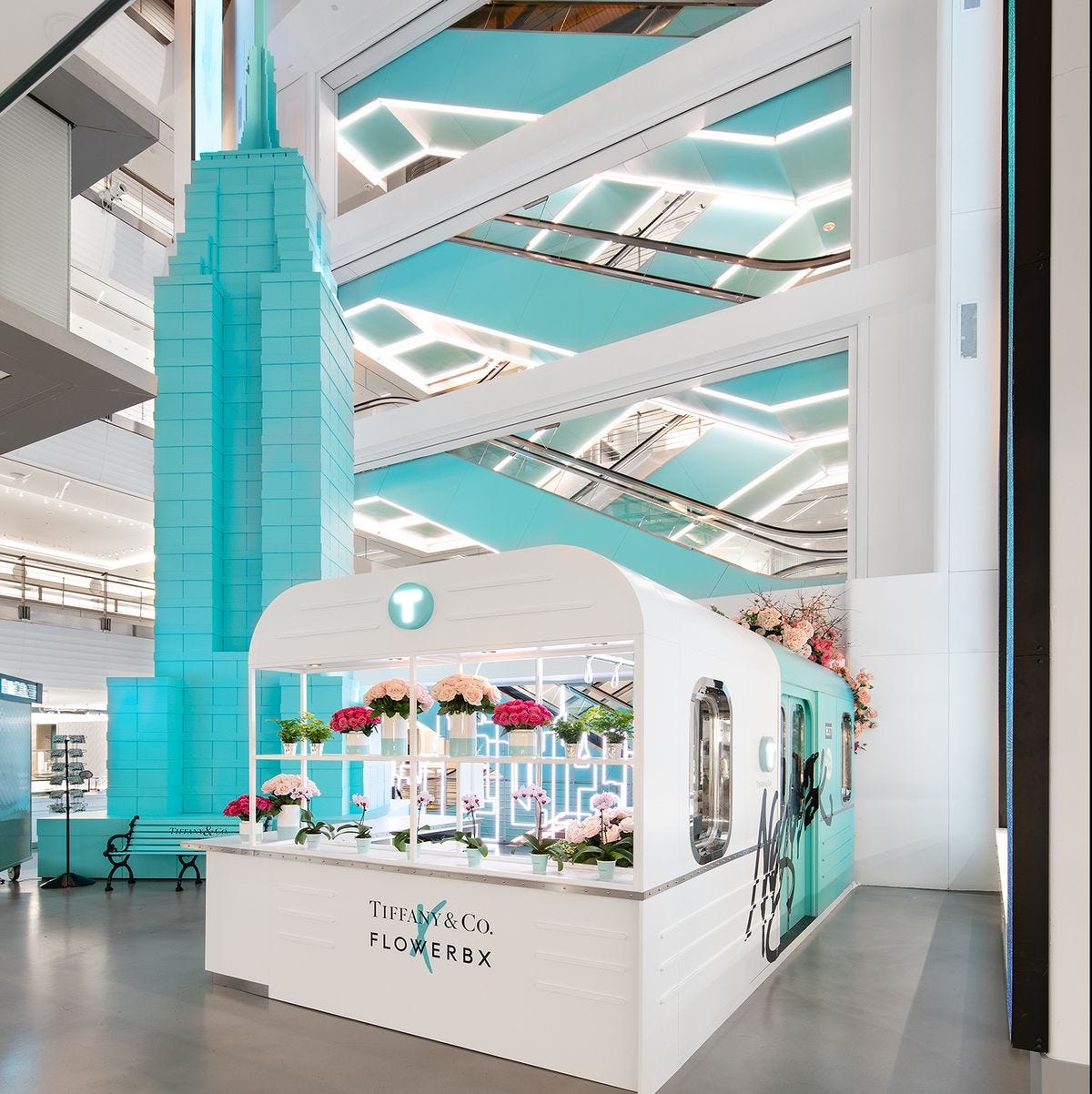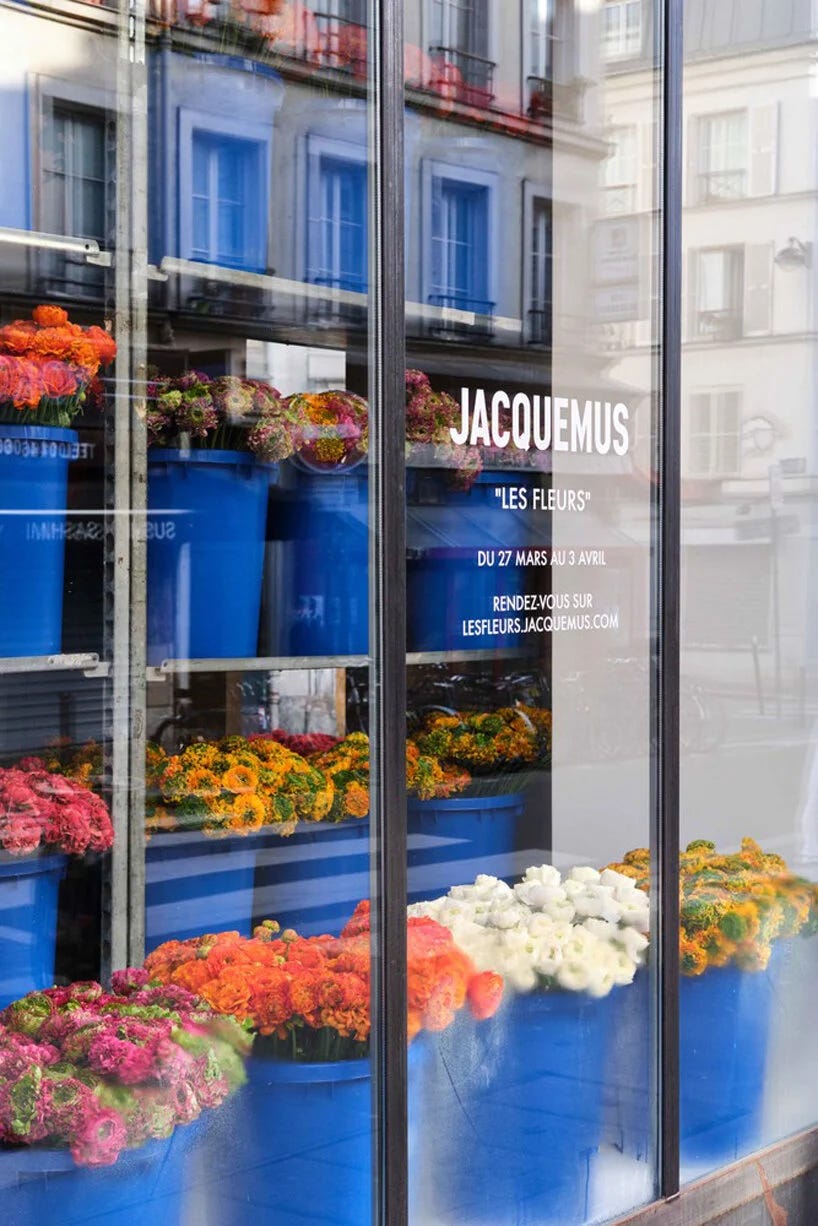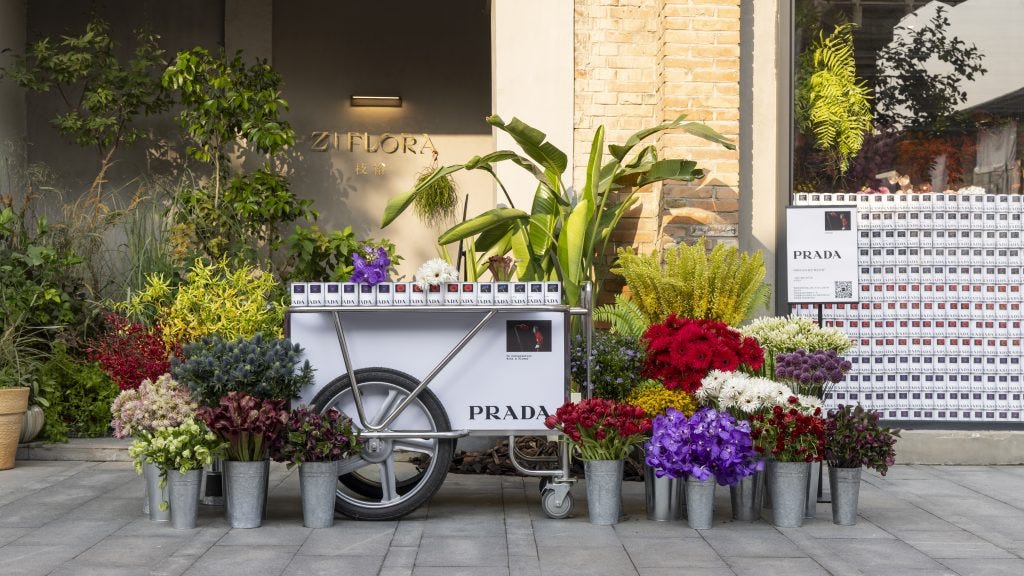Branded Florist popups: A blooming good idea.
With experiential marketing budgets by 5-10% annually. Luxury brands should wake up and smell the roses ~
Branded Coffee popups have been all the rage since the start of the year.
But, Luxury brands should wake up and smell the roses ~
TL;DR:
Experiential marketing, exemplified by pop-up flower stores, focuses on creating sensory-rich, immersive experiences that foster deep emotional connections with consumers. This approach leverages neuroscience, industry trends, and economic data to highlight the importance of genuine, memorable engagements over traditional advertising methods.
Snapshot Takeaways:
Sensory Engagement: Multisensory experiences enhance memory recall by 80%, fostering stronger brand connections.
Industry Trends: 74% of consumers prefer branded event marketing experiences, with brands increasing their experiential marketing budgets by 5-10% annually.
Economic Data: The global luxury goods market is projected to grow by 6-8% annually, driven by experiential luxury preferences.
Positive Memory Formation: Creating memorable, positive experiences helps build long-term consumer loyalty and organic brand evangelism.
Case Studies: Examples from Loro Piana, Tiffany & Co. x FLOWERBX, and Jacquemus illustrate successful experiential marketing strategies.
Key Strategies: Know your audience, collaborate locally, invest in aesthetics, promote pre- and post-event engagement, design immersive spaces, and continuously measure and iterate.
Estimated Read Time:
Approximately 8-10 minutes.
Shopping for flowers on a crisp Sunday morning is an unparalleled delight. Whether meandering down Parisian boulevards or exploring Tokyo's backstreets, one might encounter an enticing pop-up flower stall, far removed from standard marketing fads.
These stalls offer a sensory engagement strategy, weaving intricate ties between brands and passersby. In an increasingly digital world, these tangible connections, marked by real experiences, help brands find their roots, encouraging long term loyalty and advocacy.
Experiential Marketing: The New Blooms on the Block
Today's consumers, (especially the discerning ones) seek more than functional products. Traditional advertising, with its static banners and loud jingles, has become stale.
Across cafes from Tokyo to LA, it's evident that today's consumer craves stories, emotions, and connections. They yearn for experiences that resonate on a personal level. Experiential marketing answers this call, allowing brands to co-author tales of delight, intrigue, and discovery with their audience.
Experiential marketing, or rather neuroaesthetic marketing, involves crafting immersive events or experiences that immerse consumers in a brand's narrative. Unlike traditional advertising, this approach shows rather than tells why a product or service is superior. Think of an intricately designed Parisian pop-up that traces a perfume's journey from raw floral notes in Grasse to a polished flacon, instead of a mere billboard.
Beyond the Billboard: The Shift to Immersive Experiences
At its core, experiential marketing believes that the most memorable consumer engagements are active rather than passive. Shaped by technological advances and shifting consumer sentiments, experiential marketing focuses on brand attributes, bringing them to life in tangible, interactive forms.
Take the resurgence of pop-up flower stores, for example. These ephemeral shops offer urban dwellers not just flowers but moments. A carefully crafted bouquet becomes a conduit for nostalgia or a token of future adventures. Brands, from luxury fashion houses in Milan to artisan chocolatiers in Zürich, understand this. These pop-ups ground a brand's ethos in the tangible and immediate, escaping the confines of screens and glossy magazine pages to come alive amidst fragrances, textures, and the invaluable human touch.
In a world pivoting towards the digital, the allure of such experiential engagements lies in their humaneness. They offer a sensory indulgence and a reaffirmation that while pixels can tell stories, it's the fragrances, tastes, touch, and shared smiles that etch memories.
Brands Harnessing the Charm of Pop-up Flower Stores
Luxury in Simple Pleasures…
Loro Piana's Immersive Flower Pop-Up:
During Milan Fashion Week, Loro Piana showcased that real opulence often lies in understated gestures. Instead of the typical high fashion flashiness, the brand emphasized its devotion to textures and fine craftsmanship. For its SS23 collection, Loro Piana encapsulated the essence of the Italian Grand Tour, linking fashion to the passage of time and embedding stories of different eras within its garments.
Kiosks across Milan were transformed into experiential hydrangea studios, featuring Mary Lennox's floral artistry and live compositions. Visitors could take away handcrafted floral pieces, and a reimagined newsstand became a post office offering postcards illustrated by celebrated artists. This initiative championed communal interaction and redefined luxury, presenting moments of genuine, fleeting luxury. Loro Piana illustrated that authentic luxury lies in experiences and genuine connections.
Tiffany & Co. x FLOWERBX Collaboration:
In February, Tiffany & Co.'s "Tiffany’s Next Door" collaborated with London's elite florist, FLOWERBX, ahead of Valentine’s Day. The pop-up transformed the atrium into a stunning floral oasis, offering a serene break from New York's frigid winter. The collaboration marked FLOWERBX's American debut, featuring custom floral arrangements in Tiffany vases, creating a whimsical garden sanctuary.
The installation featured a white-and-Tiffany-blue subway car filled with floral arrangements, contrasting New York's urban exterior with an inside garden sanctuary. Customers could purchase floral arrangements and potted plants, including FLOWERBX's "For Love" roses in Tiffany Blue Colour Block china vases. This collaboration aligned with Tiffany’s belief in 'everyday luxury,' crafting items meant for daily life and spotlighting Tiffany's new Art Deco-style location.
Jacquemus Flower Shop:
Simon Porte Jacquemus, celebrated for revolutionising the fashion world, ventured into floristry with a unique flower pop-up store in Paris. Partnering with Les Fleurs de Paul, the pop-up titled "Les Fleurs" reflected both brands' commitment to sustainability. The shop displayed flower arrangements in recycled fabrics from Jacquemus' previous collections, showcasing sustainable cultivation of seasonal flowers.
Jacquemus emphasized his long-held passion for flowers, offering more than just clothing during challenging times. The exclusive floral venture operated with a click-and-collect or home-delivery model, merging the essence of high fashion with sustainable floristry.
The Pillars of Experiential Activities and the Role of Pop-up Flower Stores
Positive Memory Formation:
Modern cities often feel like fleeting slideshows of experiences, with brands vying for attention. Positive memory formation is a deliberate effort to etch a brand into consumers' memories as purveyors of meaningful moments. Such memories shape choices, preferences, and loyalties. A brand that instils positive memories carves a niche in both the market and the hearts of consumers.
Pop-up flower stores offer a sensory experience, with vivid colours, fragrances, and textures creating a deeply personal, emotional connection. Brands leveraging this approach are sowing seeds of memories that promise to bloom in consumers' minds. These positive memories foster loyalty, encouraging repeat visits and turning customers into organic brand evangelists.
A study from the Journal of Consumer Research supports this, revealing that multisensory experiences enhance memory recall by 80% compared to unisensory experiences. This highlights the importance of creating immersive, sensory-rich environments in experiential marketing to foster stronger brand recall and emotional connections.
Place-making:
Place-making curates environments fostering a sense of community, connection, and belonging. Pop-up flower stores infuse character into nondescript spaces, transforming them into destinations of shared admiration for flora. These initiatives ground global brands in local narratives, celebrating generosity and making luxurious brands momentarily local heroes.
Place-making offers global brands a passport into local hearts, grounding them in community sensibilities. It elevates local spaces, creating a symbiotic relationship between global and local, transforming spaces into stories and brands into local legends.
Neuro-aesthetics:
Neuro-aesthetics explores how certain visuals, sounds, or tactile sensations elicit neural responses, shaping emotions, preferences, and behaviours. Pop-up flower stores, with their vibrant petals and intricate designs, tap into our brain's aesthetic receptors. These stores craft neural symphonies, shaping perceptions, moods, and memories associated with the brand.
Harnessing neuro-aesthetics fosters stronger, more positive brand associations. Aesthetic experiences influence brand perception, sparking well-being, fond memories, or impulse purchases. Aligning with neuro-aesthetics principles, brands create resonant environments, drawing consumers back repeatedly.
Implications for Brand Loyalty and Perception
Today's vibrant retail landscape favours deep engagement over loud advertising. Experiential marketing allows brands to create memorable, meaningful moments that resonate with consumers. Pop-up flower stores offer rich sensory experiences, creating positive memory imprints that differentiate one-time visits from lifelong relationships.
These experiences turn consumers into passionate brand evangelists, sharing their exceptional experiences and advocating for the brand. Investing in transient spaces like pop-ups plants seeds of genuine, tactile connections, bridging the digital and physical worlds.
Industry Data on Experiential Marketing Growth:
The Event Marketing Institute's "EventTrack 2023" report noted that 74% of consumers say engaging with branded event marketing experiences makes them more likely to buy the products being promoted. Brands are increasing their experiential marketing budgets by an average of 5-10% annually, reflecting the strategy's rising prominence and effectiveness. This data demonstrates the growing investment in experiential marketing by brands, driven by its proven ability to influence purchasing decisions and enhance customer engagement.
Organising Successful Experiential Activities
Experiential activities must be immersive and align with the brand's ethos. Pop-up flower stores, with their sensory appeal, create exclusive, urgent engagements. Flowers evoke emotion, turning purchases into moments, emotions, and memories.
Successful experiential activities embrace the experiential, leveraging local nuances, investing in aesthetics, and continuously refining based on feedback. Brands must prioritize depth over breadth, connections over impressions, and meaning over momentariness.
Know Your Audience:
Understanding the audience's desires, preferences, and cultural underpinnings is crucial. Tailoring experiences to resonate with specific demographics, such as millennials or families, ensures deeper, more meaningful connections. In the floral domain, recognizing seasonal and cultural cues enhances relevance and resonance.
Collaborate Locally:
Immersing in local culture and collaborating with local artists, influencers, and event organisers strengthens community ties. Including native flora and sourcing locally enriches the brand's narrative, making each arrangement a testament to local beauty and a meaningful purchase for the customer.
Invest in Aesthetics:
Visual appeal forms the first connection between a brand and its audience. Designing immersive spaces that align with the brand's ethos enhances the overall narrative, making each element contribute to the sensory journey.
Promote Pre-event and Post-event Engagement:
Teasing the event and leaving customers with mementos enhances engagement. Early bird specials and post-event collages keep the brand top of mind, encouraging repeat interactions.
Design Immersive Spaces:
Aligning every inch of the environment with the brand's ethos captures the brand's spirit in three dimensions. Pop-up flower stores create escapes, merging high fashion with sustainable floristry and transporting customers into the brand's unique universe.
Measure and Iterate:
Evaluating foot traffic, sales, and feedback ensures continuous improvement.
Mapping nuances, such as popular flowers or peak traffic times, refines offerings and enhances each subsequent pop-up's success.
Economic Impact: The Rise of Experiential Luxury
The global luxury goods market is projected to grow by 6-8% annually, reaching approximately €330 billion by 2025, according to Bain & Company. A significant portion of this growth is attributed to the rise of experiential luxury, where consumers value experiences over material goods. This economic trend highlights the shift in consumer preferences towards experiential purchases, reinforcing the strategic importance of experiential marketing for luxury brands aiming to capitalize on this market growth.
Pop-up flower stores exemplify this shift, offering rich sensory experiences that resonate deeply with consumers. Brands that prioritize authenticity and connection over superficial dazzle will thrive, crafting experiences that etch memories, evoke emotions, and enrich lives. The future of branding lies in personalized, culturally sensitive, and community-oriented approaches, creating masterpieces that define a brand's legacy.




